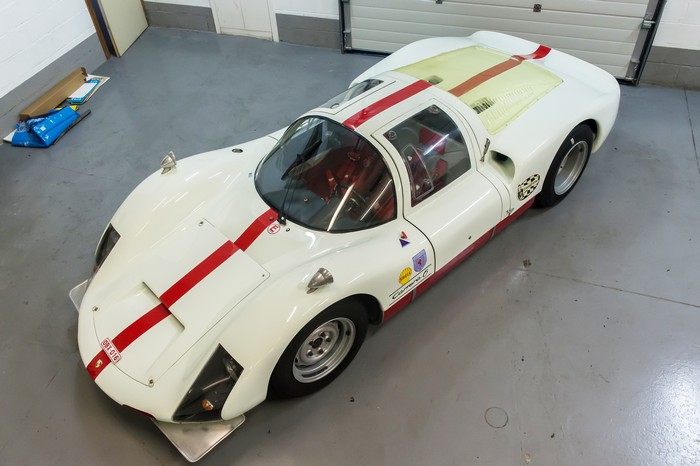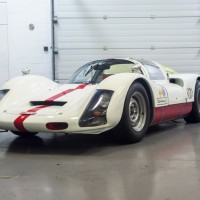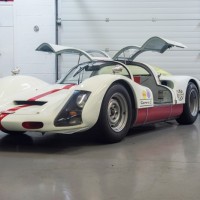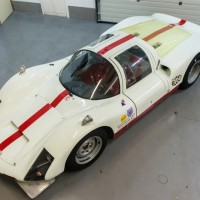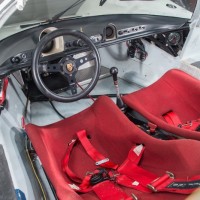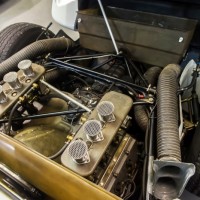This 1966 Porsche 906 sold in Paris at Bonham’s Grand Palais sale on February 7, 2013, for $732k, including buyer’s premium. At first glance, that price appears awfully favorable for the buyer.
Was no one awake in the room, or is there an issue with the car? There have been enough major adjustments in the Porsche market that an overview of the sports prototype sector with our subject 906 as centerpiece might be helpful.
If we accept Porsche Spyders as $3m collector cars, and Porsche 917s as $15m cars, we can see that the “lesser” plastic-bodied, tube-frame sports and sport prototype competition cars from Zuffenhausen — the 904s, 906s, 910s, 907s and 908s — are relatively cheap and very interesting collectibles.
SCM Analysis
Detailing
First, a little history
The second age of Porsche racing opened in 1964 with the transition from formed aluminum to the molded-fiberglass construction used in the 904. Using build techniques designed to facilitate the relatively high 100-car production for homologation stipulated by the FIA, the 904 was the last competition Porsche that could be road-licensed in Germany.
Unfortunately, the sheet-metal, box-section chassis bonded to a chopper-gun-sprayed body was very heavy, difficult to repair and prone to rust. More than one collector has been shocked by the problems this construction method presents during restoration.
The newly designed 901 6-cylinder engine was supposed to power the 904, but Porsche ultimately decided to keep using the venerable 4-cam, 4-cylinder Carrera engine. The 2-liter Type 587/3 engine performed yeoman service for Porsche’s racing (and road) customers for the next two years.
A variety of engines
The factory itself fielded a small series of 904s with the new 901 flat six. Given the unforeseen subsequent introduction of the 906 Carrera 6, these 904s were confusingly serial-numbered as 906s. Another couple of cars were powered by Type 771 8-cylinder engines. Both of these latter configurations raced as factory prototypes. The 6-cylinder and 8-cylinder cars are of great historical interest, and the Carrera 6 cars, with the easy-to-maintain 901, are eminently practical as vintage racers.
There is currently quite a bit of demand for 904s. The only competition car styled by “Butzi” Porsche, the 904 stands out in any collection. While road-licensable, I find them hot, cramped, noisy and claustrophobic. Compared with later racing models, the 904, like the 550 in its series, is the least potent. Even so, good 904s are commanding $1m and more.
The 906 Carrera 6
The Carrera 6, like the 904/6, has a 906 serial number but starts with 1xx versus 0xx. Significantly, the Carrera 6 represents a reversion to Spyder tube frame design — albeit with non-stressed, lightweight fiberglass skins. This construction method was to last for the duration of the second age of Porsche racing that terminated with the incomparable 917. Two hundred pounds lighter, 30 horsepower more powerful, the Carrera 6 dominated 2-liter sports and sports prototype racing.
As was now customary, the basic homologation model was relegated to Porsche’s clients, while non-homologated prototype cars powered by injected 6-cylinder engines and 2.2-liter, 8-cylinder 771s were factory campaigned. Today, the 906 is a capable and reliable vintage racing car. Its 901/20 engine ensures both easy parts supply and a plethora of capable repair shops.
No more dual-use racers
Now here’s an important point: Despite being an order of magnitude superior to the 904, the 906 could not be road-licensed. Mid-1960s racing technology had finally advanced to the point where successful competition cars had to be divorced from road use.
Sports car homologation rules in 1966 required only a 50-unit run. As Porsche could identify 50 racing-only sales, the now-problematic road capability was dropped. In today’s collector market, usability on both road and track commands a price premium. We see this very clearly with the Ferrari GTO and the subsequent 275 LM. The GTO is much more usable than its faster, track-only successor. What should the 906’s “track only” discount from the dual-use 904 be? Fifty percent? Less — or more?
With that preface, do we see an apparent bargain in the case of our subject car? Alas, no. Our 906 has a notorious and unfortunate history involving two major crashes.
The first crash resulted in a new chassis. The second crash — also a “total” —resulted in a driver’s death and three spectator fatalities. In the subsequent confusion, what was left of the wreck was converted —who knows how — to a Chevron-like open sports racer. Ultimately, after years of knocking about, today’s rather attractive restoration appeared. Surprisingly, the “story” discount for all this horror is a mere $300k.
Let’s return to our narrative.
On to the 910 cars
Hard on the heels of the Carrera 6 came the 910 prototype. Typical of Porsche, the 910 is a thoroughly Teutonic development of its predecessor. Employing the 906’s chassis and drivetrain, the 910 was fitted with 13-inch wheels and a wholly new suspension that dispensed with the Carrera Six’s recycled 904 corners, thereby offering greatly improved performance on the track. I have driven both, and the contrast is astounding.
The 910 has better visibility, better grip and better power to weight. As a hidden asset, most of the 28 910s were first used as factory racers before being rebuilt for customer sale. With the Works team provenance that comes with most 910s, the premium for a factory team car devolves to race history. Porsche 910s sell for around $1.2m, marginally more than Carrera 6s.
The 907 and 908 cars
Confusingly out of numeric order, Porsche followed the 910 with the 907. Essentially a right-hand-drive 910 with different coachwork and the terrifyingly complex 771 engine, the approximately 20 907s were really interim models before the emergence of the 908s.
I believe Porsche repowered 12 steel-frame, 13-inch-wheel 907s with 3-liter engines — the legal maximum for prototypes — in a planned attack for outright victories against the likes of Ferrari, Ford, Lola and so on.
Quickly, a second series of 908s appeared with aluminum tube chassis and 15-inch wheels. For 1968, the authorities permitted open cars in the prototype class. The 908 Spyders appeared in 1969, when Porsche handily won the World Championship of Makes, which was the culmination of ambitions that had been simmering since their tie-breaker loss to Ferrari in 1960.
The bigger prototypes — the few extant 907s and the 50-odd 908s — currently sell in the $2m to $2.5m range, depending on history and condition. With tube-frame, fiberglass-skin cars, heavier restorations involving tube replacement and new body panels don’t have the value-damping impact such interventions would have had with earlier sheet-metal and frame racing cars.
Perhaps this tolerance partly explains the small discount on our 906. Given their extreme scarcity (recall the subsequent appearance of those 12 steel-chassis 908s) and their very complex and specialized engines, 907s are generally the province of collectors.
By contrast, the 908 has it all. The engine was designed with street application in mind. The cars are easy to maintain, with good parts availability. These cars are a bargain, offering major historic importance, and the excellent performance that makes for front-of-the-pack vintage racing.
Finally, to return to our featured car. I would view this Carrera 6, with its serious condition issues, as well sold. It is more than fully priced as a “weapons grade” vintage racer. ?
